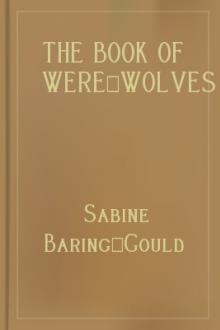The Book of Were-Wolves by Sabine Baring-Gould (best desktop ebook reader .txt) 📕

- Author: Sabine Baring-Gould
- Performer: -
Book online «The Book of Were-Wolves by Sabine Baring-Gould (best desktop ebook reader .txt) 📕». Author Sabine Baring-Gould
and we are quite content to be freed from him and his kindred, the
vampire and the ghoul. Yet who knows! We may be a little too hasty in
concluding that he is extinct. He may still prowl in Abyssinian
forests, range still over Asiatic steppes, and be found howling
dismally in some padded room of a Hanwell or a Bedlam.
In the following pages I design to investigate the notices of
werewolves to be found in the ancient writers of classic antiquity,
those contained in the Northern Sagas, and, lastly, the numerous
details afforded by the mediæval authors. In connection with this I
shall give a sketch of modern folklore relating to Lycanthropy.
It will then be seen that under the veil of mythology lies a solid
reality, that a floating superstition holds in solution a positive
truth.
This I shall show to be an innate craving for blood implanted in
certain natures, restrained under ordinary circumstances, but breaking
forth occasionally, accompanied with hallucination, leading in most
cases to cannibalism. I shall then give instances of persons thus
afflicted, who were believed by others, and who believed themselves,
to be transformed into beasts, and who, in the paroxysms of their
madness, committed numerous murders, and devoured their victims.
I shall next give instances of persons suffering from the same passion
for blood, who murdered for the mere gratification of their natural
cruelty, but who were not subject to hallucinations, nor were addicted
to cannibalism.
I shall also give instances of persons filled with the same
propensities who murdered and ate their victims, but who were
perfectly free from hallucination.
CHAPTER II.
LYCANTHROPY AMONG THE ANCIENTS.
What is Lycanthropy? The change of manor woman into the form of a
wolf, either through magical means, so as to enable him or her to
gratify the taste for human flesh, or through judgment of the gods in
punishment for some great offence.
This is the popular definition. Truly it consists in a form of
madness, such as may be found in most asylums.
Among the ancients this kind of insanity went by the names of
Lycanthropy, Kuanthropy, or Boanthropy, because those afflicted with
it believed themselves to be turned into wolves, dogs, or cows. But in
the North of Europe, as we shall see, the shape of a bear, and in
Africa that of a hyæna, were often selected in preference. A mere
matter of taste! According to Marcellus Sidetes, of whose poem {Greek
perì lukanðrw’pou} a fragment exists, men are attacked with this
madness chiefly in the beginning of the year, and become most furious
in February; retiring for the night to lone cemeteries, and living
precisely in the manner of dogs and wolves.
Virgil writes in his eighth Eclogue:—
Has herbas, atque hæc Ponto mihi lecta venena
Ipse dedit Mris; nascuntur plurima Ponto.
His ego sæpe lupum fieri et se conducere sylvis
Mrim, sæpe animas imis excire sepulchris,
Atque satas alio, vidi traducere messes.
And Herodotus:—“It seems that the Neuri are sorcerers, if one is to
believe the Scythians and the Greeks established in Scythia; for each
Neurian changes himself, once in the year, into the form of a wolf,
and he continues in that form for several days, after which he resumes
his former shape.”—(Lib. iv. c. 105.)
See also Pomponius Mela (lib. ii. c. 1) “There is a fixed time for
each Neurian, at which they change, if they like, into wolves, and
back again into their former condition.”
But the most remarkable story among the ancients is that related by
Ovid in his “Metamorphoses,” of Lycaon, king of Arcadia, who,
entertaining Jupiter one day, set before him a hash of human flesh, to
prove his omniscience, whereupon the god transferred him into a
wolf:— [1]
[1. OVID. Met. i. 237; PAUSANIAS, viii. 2, § 1; TZETZE ad Lycoph.
481; ERATOSTH. Catas. i. 8.]
In vain he attempted to speak; from that very instant
His jaws were bespluttered with foam, and only he thirsted
For blood, as he raged amongst flocks and panted for slaughter.
His vesture was changed into hair, his limbs became crooked;
A wolf,—he retains yet large trace of his ancient expression,
Hoary he is as afore, his countenance rabid,
His eyes glitter savagely still, the picture of fury.
Pliny relates from Evanthes, that on the festival of Jupiter Lycæus,
one of the family of Antæus was selected by lot, and conducted to the
brink of the Arcadian lake. He then hung his clothes on a tree and
plunged into the water, whereupon he was transformed into a wolf. Nine
years after, if he had not tasted human flesh, he was at liberty to
swim back and resume his former shape, which had in the meantime
become aged, as though he had worn it for nine years.
Agriopas relates, that Demænetus, having assisted at an Arcadian human
sacrifice to Jupiter Lycæus, ate of the flesh, and was at once
transformed into a wolf, in which shape he prowled about for ten
years, after which he recovered his human form, and took part in the
Olympic games.
The following story is from Petronius:—
“My master had gone to Capua to sell some old clothes. I seized the
opportunity, and persuaded our guest to bear me company about five
miles out of town; for he was a soldier, and as bold as death. We set
out about cockcrow, and the moon shone bright as day, when, coming
among some monuments. my man began to converse with the stars, whilst
I jogged along singing and counting them. Presently I looked back
after him, and saw him strip and lay his clothes by the side of the
road. My heart was in my mouth in an instant, I stood like a corpse;
when, in a crack, he was turned into a wolf. Don’t think I’m joking: I
would not tell you a lie for the finest fortune in the world.
“But to continue: after he was turned into a wolf, he set up a howl
and made straight for the woods. At first I did not know whether I was
on my head or my heels; but at last going to take up his clothes, I
found them turned into stone. The sweat streamed from me, and I never
expected to get over it. Melissa began to wonder why I walked so late.
‘Had you come a little sooner,’ she said, ‘you might at least have
lent us a hand; for a wolf broke into the farm and has butchered all
our cattle; but though be got off, it was no laughing matter for him,
for a servant of ours ran him through with a pike. Hearing this I
could not close an eye; but as soon as it was daylight, I ran home
like a pedlar that has been eased of his pack. Coming to the place
where the clothes had been turned into stone, I saw nothing but a pool
of blood; and when I got home, I found my soldier lying in bed, like
an ox in a stall, and a surgeon dressing his neck. I saw at once that
he was a fellow who could change his skin (versipellis), and never
after could I eat bread with him, no, not if you would have killed me.
Those who would have taken a different view of the case are welcome to
their opinion; if I tell you a lie, may your genii confound me!”
As every one knows, Jupiter changed himself into a bull; Hecuba became
a bitch; Actæon a stag; the comrades of Ulysses were transformed into
swine; and the daughters of Prtus fled through the fields believing
themselves to be cows, and would not allow any one to come near them,
lest they should be caught and yoked.
S. Augustine declared, in his De Civitate Dei, that he knew an old
woman who was said to turn men into asses by her enchantments.
Apuleius has left us his charming romance of the Golden Ass, in
which the hero, through injudicious use of a magical salve, is
transformed into that long-eared animal.
It is to be observed that the chief seat of Lycanthropy was Arcadia,
and it has been very plausibly suggested that the cause might he
traced to the following circumstance:—The natives were a pastoral
people, and would consequently suffer very severely from the attacks
and depredations of wolves. They would naturally institute a sacrifice
to obtain deliverance from this pest, and security for their flocks.
This sacrifice consisted in the offering of a child, and it was
instituted by Lycaon. From the circumstance of the sacrifice being
human, and from the peculiarity of the name of its originator, rose
the myth.
But, on the other hand, the story is far too widely spread for us to
attribute it to an accidental origin, or to trace it to a local
source.
Half the world believes, or believed in, werewolves, and they were
supposed to haunt the Norwegian forests by those who had never
remotely been connected with Arcadia: and the superstition had
probably struck deep its roots into the Scandinavian and Teutonic
minds, ages before Lycaon existed; and we have only to glance at
Oriental literature, to see it as firmly engrafted in the imagination
of the Easterns.
CHAPTER III.
THE WEREWOLF IN THE NORTH.
In Norway and Iceland certain men were said to be eigi einhamir, not
of one skin, an idea which had its roots in paganism. The full form of
this strange superstition was, that men could take upon them other
bodies, and the natures of those beings whose bodies they assumed. The
second adopted shape was called by the same name as the original
shape, hamr, and the expression made use of to designate the
transition from one body to another, was at skipta hömum, or _at
hamaz_; whilst the expedition made in the second form, was the hamför.
By this transfiguration extraordinary powers were acquired; the
natural strength of the individual was doubled, or quadrupled; he
acquired the strength of the beast in whose body he travelled, in
addition to his own, and a man thus invigorated was called hamrammr.
The manner in which the change was effected, varied. At times, a dress
of skin was cast over the body, and at once the transformation was
complete; at others, the human body was deserted, and the soul entered
the second form, leaving the first body in a cataleptic state, to all
appearance dead. The second hamr was either borrowed or created for
the purpose. There was yet a third manner of producing this effect-it
was by incantation; but then the form of the individual remained
unaltered, though the eyes of all beholders were charmed so that they
could only perceive him under the selected form.
Having assumed some bestial shape, the man who is eigi einhammr is
only to be recognized by his eyes, which by no power can be changed.
He then pursues his course, follows the instincts of the beast whose
body he has taken, yet without quenching his own intelligence. He is
able to do what the body of the animal can do, and do what he, as man,
can do as well. He may fly or swim, if be is in the shape of bird or
fish; if he has taken the form of a wolf, or if he goes on a
gandreið, or wolf’s-ride, he is fall of the rage and malignity of
the creatures whose powers and passions he has assumed.
I will give a few instances of each of the three methods of changing
bodies mentioned above.





Comments (0)